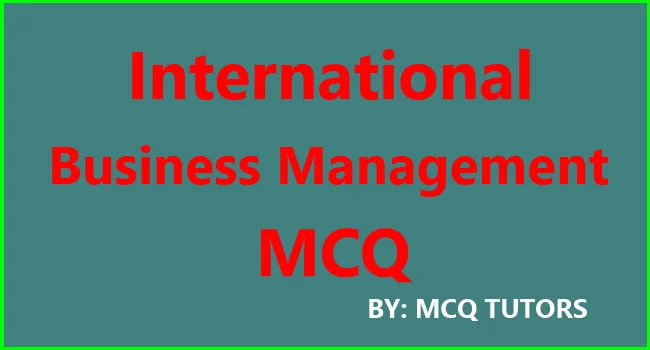Foreign Trade of India mcqs with Answer | International trade mcqs with answers pdf
Are you looking to become an expert in international trade? This article provides a comprehensive guide to Foreign Trade of India mcqs with Answer. It covers the key topics and concepts related to this subject, as well as providing practice questions with answers in PDF format.
With this article, you will gain a detailed understanding of the regulations, policies and procedures that govern foreign trade in India. In addition, you will also get a deeper insight into the practical aspects of foreign trade with helpful tips and advice.

50 Foreign Trade of India mcqs with Answer | International trade mcqs with answers pdf
1. Mercantilists viewed international trade as extremely beneficial to a ___.
Ans. Nation
2. To be able to understand the complexity of international competition, it is imperative also to appreciate the motives driving towards international trade. (True/False)
Ans. True
3. In his Wealth of Nations, Adam Smith promoted free trade by comparing nations to households. (True/False)
Ans. True
4. According to Adam Smith, trade between ___ nations is based on absolute advantage.
Ans. Two
5. The reason that international trade produces this increase in world output is that it allows each country to specialize in producing the good in which it has a comparative advantage. (True/False)
Ans. True
6. The Ricardian theory of comparative costs was based on a number of simplifying ___.
Ans. Assumptions
7. The leading theory of what determines nations’ trade patterns emerged from Heckscher, and developed by Ohlin in the 1980s. (True/False)
Ans. False
8. According to Kravis, there are four bases of the ___ factor.
Ans. Availability
9. In the H-O model, factors of production are scarce of abundant in absolute terms and not in relative terms. (True/False)
Ans. False
10. When there is ___, each country has to consume what it produces.
Ans. Autarky
11. On the eve of planning, the foreign trade of India showed an ___ of imports over exports.
Ans. Excess
12. During the First Plan, a massive programme of industrialization was initiated. (True/False)
Ans. False
13. Imports have been classified into ___ and non-bulk imports.
Ans. Bulk imports
14. During 1999-2000 and 2000-01, there has been a sharp increase in the international price of crude oil. (True/False)
Ans. True
15. The imports of consumer goods and foodgrains accounted for 40 per cent of India’s imports during the First Plan period. (True/False)
Ans. True
16. From 1957 onwards, import of foodgrains was considered too high and these were arranged through ___ aid from USA.
Ans. PL480
17. Fruits and vegetables share decreased in 2010-11 to 0.42 per cent, which was 4.14 per cent in 2000-01. (True/False)
Ans. True
18. Rice share decreased in 2010-11 to 0.93 per cent, which was ___ per cent in 2000-01.
Ans. 1.41
19. Over the years, there has been a constant ___ in the share of agricultural raw materials and allied products exports, due to increase in population.
Ans. Decline
20. The pattern of India’s exports indicates that non-traditional items of exports are losing their importance. (True/False)
Ans. False
21. India has had strong trade relations with North America comprising USA and Canada. (True/False)
Ans. True
22. Our trade with the countries in Asia and Oceania (other OECD countries) has been of ___ significance.
Ans. Great
23. India’s ranking among the leading exporters and importers improved from 31 to___ in 2000.
Ans. 26
24. China’s export growth ranged from 6.5 per cent to 48 per cent in terms of the percentage of emerging and developing economies in global exports. (True/False)
Ans. True
25. There is greater diversification in India’s exports but still share of the top fifteen countries is also very high at the level of 60 per cent in 2010-11. (True/False)
Ans. True
26. India enjoys surplus trade with the ___ from which it imports large quantities of oil.
Ans. UAE
27. Western developed countries lag behind in the world’s exports of US$ 3.7 trillion in terms of commercial services. (True/False)
Ans. False
28. India experienced extremely good performance and growth in the context of ___ major classes of commercial services.
Ans. Three
29. Growth of ___ was experienced in 2010-11 in the import of services.
Ans. 40 per cent
30. Surplus in services exports took care of about 41 per cent of deficit on account of merchandise trade. (True/False)
Ans. True
31. Imports have been classified into bulk imports and non-bulk imports. (True/False)
Ans. True
32. A close look at import data reveals that there has been a persistently rising trend of ___ which is the result of both internal and external factors.
Ans. Imports
33. The import of foodgrains was necessitated by the partition of the country and the growing demand for food for the increasing population. (True/False)
Ans. True
34. India imports ___ and steel and also some non-ferrous metals.
Ans. Iron
35. Although ___ constituted the largest share in 2005-06 yet the share of this port has declined over the years.
Ans. Mumbai Air
36. In terms of growth, the imports of cargoes through Ahmadabad air was maximum (78.46 per cent) in 2009-10. (True/False)
Ans. True
37. The sharp increase in POL imports encouraged non-POL imports to increase adequately as well. (True/False)
Ans. False
38. Movements in the ___ and imports of India took place by five to seven folds in 2000 decade.
Ans. Exports
39. Exports of India are generally classified into four categories. (True/False)
Ans. True
40. From 1970-71 to 2010-11 there is a sharp decline in the share of ___ and allied products.
Ans. Agriculture
41. ___ encourages the foreign earnings as well as stimulates greater economic activities.
Ans. Trade
42. Vigorous promotion of exports was emphasized after the Second Plan to earn foreign exchange in order to overcome the acute foreign exchange crisis. (True/False)
Ans. True
43. The top four items in India’s manufactured exports are engineering goods, gems and jewellery, chemicals and related products, and textiles. (True/False)
Ans. True
44. There is a fall in shares of ___ and also of cotton, yarn, fabrics, made-ups etc., to a single digit level since 2000-01.
Ans. Ready-made garments
45. There have not been many changes in the sectoral composition of India’s exports basket from 2000 onwards. (True/False)
Ans. False
46. The only item which experienced negative growth in the first half of 2011-12 was ___.
Ans. Ores and minerals
47. In terms of 48 out of total 99 items at 2 digit HS level, India experienced global export share of 1 per cent in 2009. (True/False)
Ans. True
48. India enjoyed a share of 5 per cent and above in terms of ___ items out of top 100 imports of the world in 2010.
Ans. Six
49. Among the Indian ports, ___ handles the largest volume of export cargo.
Ans. Nhava Sheva Sea
50. The ports which achieved the highest growth rates in 2009-10, as compared to the previous year, are Marmagoa Sea and Chennai Air. (True/False)
Ans. True
You may like to read tips for Students to create compelling summaries
Conclusion:
The Foreign Trade of India MCQs with Answer have provided a comprehensive overview of the complexities and nuances of international trade.
The questions have given readers an understanding of the various aspects that need to be taken into consideration when engaging in international trade.
By understanding these principles, readers can make informed decisions about their own businesses, whether they involve foreign or domestic commerce. Furthermore, by being aware of current regulations and policies, businesses can remain compliant and avoid any potential repercussions from non-compliance.
Read more:



